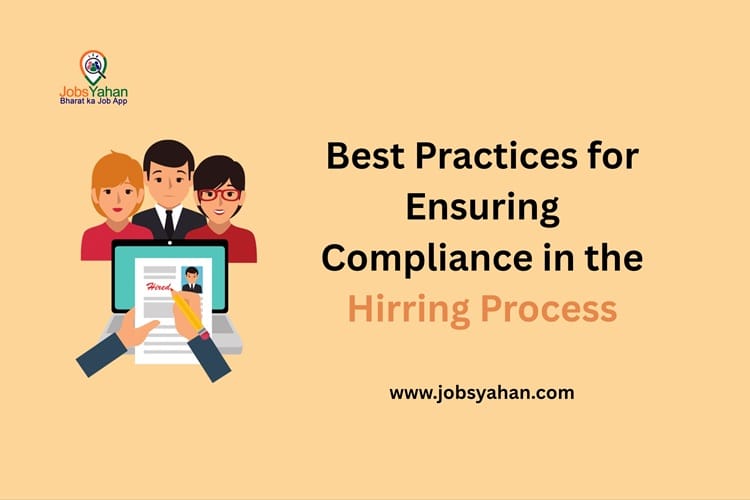
Recruitment today isn’t just about matching the right talent with the right job. Businesses must navigate a complex web of regulations, labor laws, and ethical standards from depositing in legalese territory to achieving commercial fame. Or, we must truly abide by the letter of the law. Turned into the practice of smart and efficient pulling in of talent.
What Recruitment Compliance Is And Isn’t
There are sophisticated, multifaceted issues that come into play when companies recruit talent on a global scale. Recruitment compliance is the process of determining that every practice a company uses matches all legal requirements at the local, national, and international levels under labor and anti-discrimination laws. It extends to every stage of the hiring process posting jobs, screening applications, conducting interviews, select-offs, onboarding and offers. Failure to comply could open employers up to litigation, fines, or PR against an employer’s brand.
Here’s why an agile, mission-driven organization is able to leverage a workforce recruiting compliance checklist to stay ahead of the pack and set up repeatable hiring processes to ensure they never find themselves slowly sinking in the enforcement tsunami of litigation. It offers confidence that each and every hiring decision is made fairly and equitably, consistently, openly, and transparently, and in line with regulatory requirements.
DTO Privacy Policy General Data Protection Regulation International Recruitment.
Support for local labor and diversity requirements.
Best Practices for Ensuring Recruitment Compliance.
Here are key best practices that every organization should ensure in its recruitment to be deemed fully compliant:
Standardize Job Descriptions
Be careful not to use language that may be discriminatory or too vague in the posting of a job. Skills and qualifications listed should be those related to and essential for the job. Duties, working conditions, and physical demands should be well defined to comply with ADA and ensure fairness.
Pro tip, It is suggested to get your job descriptions tested through a bias-checking tool to remove any gendered or exclusionary language.
Train Your Hiring Managers on Compliance
Routine training for recruitment compliance law allows hiring teams to understand what is and isn’t allowed, particularly when it comes to asking questions about age, marital status, religion, or nationality.
Required subjects are as follows.
Enforcement of anti-discrimination laws
Being on the other side of the table, interviewing dos and don’ts
Ability, disability, accommodations
The above list is not finalized or exhaustive.
Get Written Consent to Conduct Background Checks.
Before you run any background or credit checks, get written consent from the applicant. Additionally, tell them what their rights are under the FCRA and give them a copy of the report if you take action based on the report’s findings.
Consent forms should be kept in a safe space to be part of the candidate’s hiring record.
Guarantee Equal Pay and Benefits Disclosure
When making an offer, do not have differences in salary or packages offered to candidates that discriminate based on gender, ethnicity, or any other protected characteristic. Keep a written basis for salary offers in order to provide a possible defense to any claims of pay equity violations.
Best practice to increase transparency and attract a diverse and talented applicant pool. State the salary range in all job postings.
Audit Your Hiring Process On the Reg.
Make it a practice to audit your own internal processes and pinpoint where your recruitment-to-recruitment gaps exist. Payment data: consider a set of alternate routes to explore candidate-by-candidate feedback and rectify patterns indicative of bias or Title VII non-compliance.
Quick bonus tip: after your audit, you should be looking at your recruiting compliance checklist and updating it every year.
Keep a Detailed, Complete Paper Trail
From a submitted resume and an interview’s notes to an offer letter and a background check, this acts as a continuous record and trail and a building block to maintain consistent, thorough documentation of all recruiting activities. These two can also act as a record if a future court challenge or government audit arises.
Federal Documentation Requirements Checklist.
Candidate in-person interview assessment.
To ensure strong compliance and outcome, attendance records.
Hoping to get even more practice-related advice? Then look no further.
As too many communities have learned the hard way over the years, inclusion and compliance are not the same thing. Provide federal funding for outreach to recruit underrepresented groups of students and create a diverse talent pool of candidates. Train all hiring managers to understand how to require them to provide these accommodations to candidates with disabilities at every stage of the hiring process.
Embed metrics into your company’s D&I initiatives. Promote a more equitable workplace. That can make it seem like beneficial HR compliance is just the smart choice for your company going forward.
Conclusion
Compliance in recruitment is far more than a risk mitigation; it's about building a brand that’s perceived as being fair, transparent, and embedded in the local community.
A good recruiting compliance checklist does more than just provide a legal defense. It’s a competitive advantage that allows you to keep your organization—and your candidates—safe. By weaving these best practices into their processes, employers can create more equitable hiring pipelines that are faster, fairer and rooted in legal and ethical best practices.
JobsYahan is an intuitive web- and mobile-based platform designed to streamline the employment process for India's workforce. Tailored specifically for skilled, semi-skilled, and unskilled workers, it offers a vernacular and location-based approach to job searching and recruitment.







